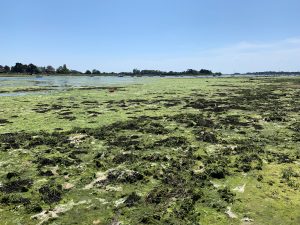Awards 2021 Winner’s Spotlight: In Practice Award
Allison Potts, David Hayward and Debbie Tann
Solent Nutrients: an opportunity to build back better?
Published December 2020
In November 2018, the European Court of Justice ruled on a case known as Dutch Nitrogen (European Court of Justice 2018). This judgement has implications for European protected sites in unfavourable condition or where environmental benchmarks are exceeded or close to exceedance. The judgement concludes that, where a European protected site is in unfavourable conservation status, the ability to permit activities which would give rise to additional pollution is ‘necessarily limited’ and would need careful justification to ensure that it is compatible with the Habitats Directive. It suggests that there would be ‘limited’ circumstances in which such plans or projects could be permitted.

Nutrients, including nitrogen and phosphorus, from agricultural and residential sources are damaging coastal sites, designated for habitats and bird species, in the Solent between the Isle of Wight and Hampshire on England’s south coast. The elevated level of nutrients accelerates the growth of algae, smothering habitats and altering species composition. There are also impacts on seagrass and saltmarsh habitats, such as physical smothering by algae and/or high nutrient levels destabilising saltmarsh root systems. Natural England advised the 15 affected Local Planning Authorities that residential development is likely to have a significant effect on the European protected sites in the area and pointed out that, if development came forward with mitigation that counterbalanced its nutrient contribution, then the authorities could be certain that no adverse effect would occur and could grant planning permission.
 To allow calculations and delivery of Nutrient Neutrality, Natural England created and refined a methodology to calculate nitrogen budgets for development, enabling the identification of counterbalancing mitigation measures to achieve neutrality. This article outlines the methodology and case studies of its implementation is areas across the region.
To allow calculations and delivery of Nutrient Neutrality, Natural England created and refined a methodology to calculate nitrogen budgets for development, enabling the identification of counterbalancing mitigation measures to achieve neutrality. This article outlines the methodology and case studies of its implementation is areas across the region.
Authors also note that, while Nutrient Neutrality is key to enabling development to proceed without harm to the European sites, in general it will not recover them to favourable condition. The new Environmental Land Management Schemes are highlighted as potential vehicles to deliver improvements at the scale needed to do so, but also the possible need for additional regulation of nutrient sources.
Over the last few weeks, we have been posting further information on each of the 2021 CIEEM Awards Winners over on our blog. Further details on each project/individual is set out in our 2021 CIEEM Awards Booklet.

